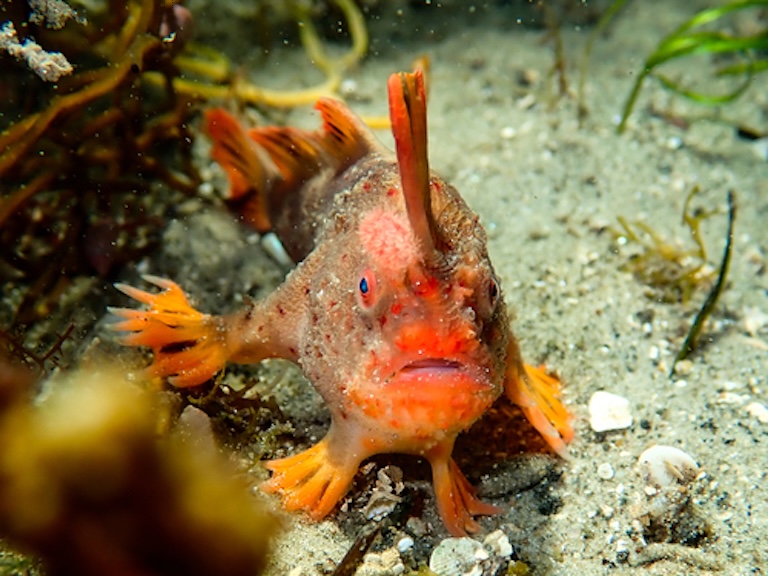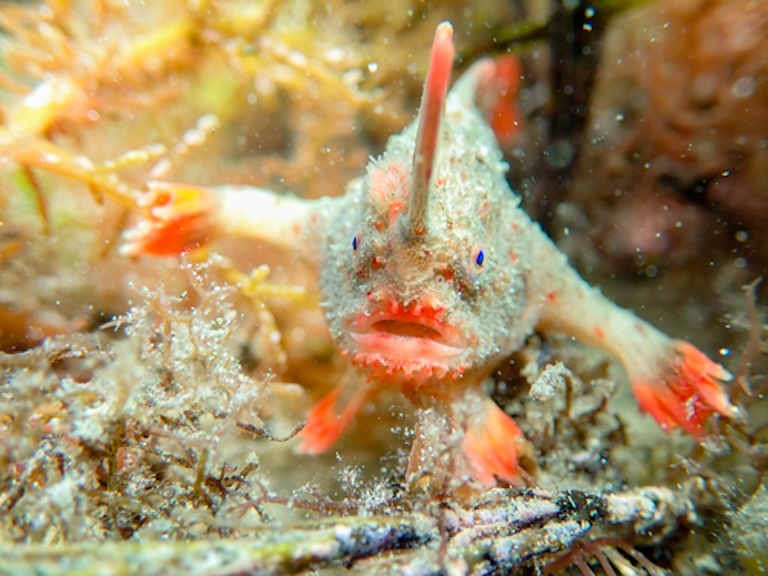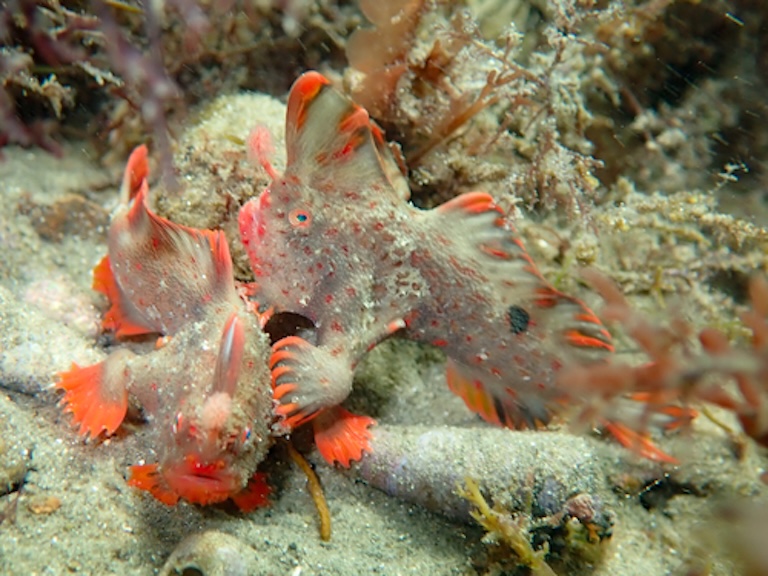Red Handfish Profile
Deep sea anglers are perhaps the most iconic of the “Alt” fishes. Known to be exactly as pretty as they need to be in the dark, and for hanging glowing lures in front of their enormous and grotesque faces, they are what comes to mind when the angler fish name is mentioned.
But they’re not all monsters of the deep. One family of the angler order is a lot easier to reach, and certainly as weird.
Unfortunately, it is one of the most profoundly threatened families of fish, and of them all, the red handfish may be the rarest of the lot.

Red Handfish Facts Overview
| Habitat: | Benthic marine, shallow reef |
| Location: | Two small reefs in Tasmania |
| Lifespan: | Unknown, probably around 10 years |
| Size: | Up to 14 cm (5.5 in) |
| Weight: | Around 12 g (0.4 oz) |
| Colour: | Bright red or mottled with a pink body and red patches |
| Diet: | Small crustaceans and polychaete worms |
| Predators: | Not listed |
| Top Speed: | Slow |
| No. of Species: | 1 |
| Conservation Status: | Critically Endangered |
Red handfish are shallow-water anglers, and members of a family with many threatened species in it.
But with only around 100 individuals left in the world, this species is one of the most threatened animals on the planet, and to make matters worse, it is woefully under-studied.
Much of what’s assumed about this species comes from inferences based on similar relatives, and its life history still isn’t well understood either. One thing is for sure: it’s almost gone from the world. Thankfully, though, some very recent developments has just tripled its global population.
Interesting Red Handfish Facts
1. They’re anglers
The Lophiiformes order is where all the fishes commonly known as anglerfishes live. These fish are known for their strange looks and behaviour, but the deep, bug-eyed monsters take most of the limelight, yet there are others in the family who are not as famous.
The suborder Antennarioidei contains anglers that have adapted to benthic, or sea-floor, living, and within it, there is a family of so-called handfishes, the Brachionichthyidae which have particularly hand-like appendages for doing so.
Of the handfishes, the Thymichthys contains two such beasts, characterised by their warty appearance, and to make matters worse, Thymichthys politus is also red.
Usually, when something is red and warty we don’t want to talk about it, but for this fish, we will make an exception. Besides, it’s not always red.

2. There are two colours
There are two colour morphs in this species, which is pretty remarkable given some of the other facts on this list. One is a bright red morph with vivid fins tipped in blue and white, and this is the one mostly seen in pictures.
The other is a mottled pink colour and has patchy, translucent fins, and this one is even rarer to see. Before we get into why this is, let’s cover the first half of the name.
3. They walk on their hands
Being benthic animals, the handfish fins have adapted to pulling their bodies along the ground, rather than pushing them through the water.
These hand-like fins give the animal an even stranger appearance than it already inherited from its angler lineage, but allow it to occupy quite a variety of substrate conditions, from rocks to sand and things in between.
They can swim, they just don’t unless it’s absolutely necessary; this is a fish that takes life quite slowly. 1
4. They reproduce slowly
Red handfish don’t go very far or do very much. Their dispersal rates are very slow, as are their rates of reproduction, which involve an egg mass of just 30 to 60 eggs once a year.
Unless you’re Mormon, 30-60 offspring should seem like a lot, but in the ocean, eggs get swallowed up like caviar, so many fish lay hundreds, thousands, or even millions of eggs to compensate for this.
The handfish eggs do have the added advantage of being stuck to algae and fiercely guarded, which reduces the risk of predation, but once hatched, the juveniles barely go anywhere and settle around the location almost immediately. They travel no more than around 50 metres per year.
This slow rate of reproduction and low dispersal incentive means they’re vulnerable to changes in their local habitats.

5. Sea urchins are a problem
The algae that these fish need to attach their eggs to is under threat from sea urchin blooms.
Displacement or destruction of urchin predators like the rock lobsters from the region has allowed the spiny algae-guzzlers to go wild, and they are rapidly decreasing the viable reproductive sites for the handfishes.
It’s been noted that the handfish try to attach their eggs to different kinds of algae in response to this, but they are often washed away before they can hatch.
This is a serious problem because it appears there are only about two locations left where these fish can be found.
6. They’re incredibly rare
Population estimates are very difficult to get right for this species for the simple reason that there aren’t very many around. There are two known fragmented populations off the coast of Tasmania, and one site survey returned an estimate of only seven adults at one of the sites.
There’s also evidence that the situation is getting worse, and with only around 100 red handfish estimated to exist, things are looking tight. 2
7. And Critically Endangered
Unsurprisingly, this has led to their listing as Critically Endangered by the IUCN, and efforts to protect their native habitats are urgent.
This is now one of the most endangered marine fish and contributes to making Brachionichthyidae the most threatened marine bony fish family as a whole. The closely related smooth handfish, not seen for 200 years, is now considered extinct, and it seems this one is about to follow suit.
However, there is hope from captive breeders. 3
8. They can be bred in captivity
Conservation for this species requires a multi-pronged approach.
Protection of their habitat and the fish themselves is important and this comes in the form of legal restrictions on its harvesting, rebalancing of urchin predators and other seaweed-focused conservation to provide ample foraging and breeding substrates.
But ex-situ conservation is also critical, and luckily this species can be reared in captivity.
Just in time for Christmas, 2024, 200 new handfish hatchlings from a captive breeding program in southern Tasmania have tripled the global population and provided the first glimpses of just how derpy baby red handfish look.
This is very promising news for the species, though protections are still not in place for their habitats yet.

Red Handfish Fact-File Summary
Scientific Classification
| Kingdom: | Animalia |
| Phylum: | Chordata |
| Class: | Actinopterygii |
| Order: | Lophiiformes |
| Family: | Brachionichthyidae |
| Genus: | Thymichthys |
| Species: | politus |
Fact Sources & References
- Graham Edgar (Year), “SYSTEMATIC SURVEYING OF TWO THREATENED HANDFISH SPECIES”, Reef Life Survey.
- Tyson J. Bessell (2024), “Population parameters and conservation implications for one of the world’s rarest marine fishes, the red handfish (Thymichthys politus)”, Wiley Online Library.
- “Red Handfish”, IUCN Red List.
